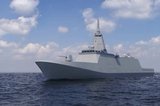Textron nets contract to develop mine countermeasure system that doesn't need towing
The MAGNUSS onboard payload system follows on from the towed mine sweep Unmanned Influence Sweep System (UISS) pictured above, which is integrated onto USVs. (Photo: Textron Systems)
The US Office of Naval Research (ONR) has awarded a new contract to Textron to build a new mine countermeasures (MCM) payload for MCM USVs that does not need towing.
Worth $20.7 million, the contract covers development of the Magnetic and Acoustic Generation Next Unmanned Superconducting Sweep (MAGNUSS) MCM technology.
The payload comprises a high-temperature superconducting magnetic source with advanced acoustic gear.
MAGNUSS is an ONR-sponsored future naval capability effort expected to transition into a Naval Sea Systems Command programme to equip the MCM USV.
Work on the contract is expected to be concluded by March 2026.
Textron Systems project
Already have an account? Log in
Want to keep reading this article?
More from Naval Warfare
-
![Future of the Canadian Patrol Submarine Project is still unclear]()
Future of the Canadian Patrol Submarine Project is still unclear
The Canadian government remains tight-lipped on the timeline and funding required for the next steps of its Canadian Submarine Patrol Project, which should offer improved capabilities for the country’s navy.
-
![Mitsubishi eyes future with Australia’s Mogami selection]()
Mitsubishi eyes future with Australia’s Mogami selection
With Australia’s selection of the Mogami-class for Project Sea 3000, Mitsubishi is investigating local production in the next decade as potential export opportunities emerge.
-
![Thales’ new Sonar 76Nano could equip UK Royal Navy on anti-submarine warfare missions]()
Thales’ new Sonar 76Nano could equip UK Royal Navy on anti-submarine warfare missions
The new sonar is designed to equip uncrewed underwater vessels, with the potential to be used by the Royal Navy for its Atlantic Bastion and Atlantic Net missions.
-
![Hanwha wins Australian government approval to increase its stake in Austal]()
Hanwha wins Australian government approval to increase its stake in Austal
The contract would mean the two shipbuilders can collaborate strategically and enhance shipbuilding capabilities in Western Australia.























